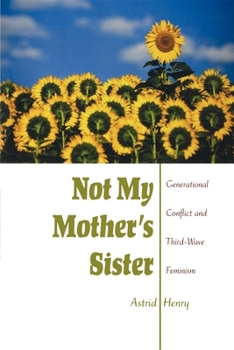Not My Mother's Sister: Generational Conflict and Third-Wave Feminism
Select Format
Select Condition 
Book Overview
"No matter how wise a mother's advice is, we listen to our peers." At least that's writer Naomi Wolf's take on the differences between her generation of feminists--the third wave--and the feminists who came before her and developed in the late '60s and '70s--the second wave. In Not My Mother's Sister, Astrid Henry agrees with Wolf that this has been the case with American feminism, but says there are problems inherent in drawing generational lines.
Henry...
Format:Paperback
Language:English
ISBN:025321713X
ISBN13:9780253217134
Release Date:September 2004
Publisher:Indiana University Press
Length:288 Pages
Weight:0.95 lbs.
Dimensions:0.8" x 6.4" x 9.4"
Age Range:18 years and up
Grade Range:Postsecondary and higher
Customer Reviews
2 ratings
A marvelous book in several ways
Published by Thriftbooks.com User , 17 years ago
I have recently been reading a wide range of books in women's studies broadly conceived for a project whose details I won't go into. Of all the books that I have read so far, in many ways I have found this one to be both the most informative and the most illuminative. Although the main purpose of the book is to explore the generational conflict between second and third wave feminism, it in fact manages to do much more than explore merely that issue. Astrid Henry is an ideal person to undertake this study. Agewise she belongs to the third wave of feminism, while at the same time holding the second wave in much higher regard than the bulk of those feminists comprising the third wave. "Second wave" refers, of course, to the reemergence of the women's movement in the sixties and seventies in America. The "first wave" is considered to be the feminists of the last half of the 19th century and the first two decades of the 20th, the years between the passing of universal suffrage and the revival of the women's movement in the sixties and seventies considered a period in which the women's movement was largely nonexistent (historian William H. Chafe has written an interesting book on what happened during these decades when supposedly nothing happened, THE AMERICAN WOMAN: HER CHANGING SOCIAL, ECONOMIC, AND POLITICAL ROLES 1920-1970). The second wave was comprised by a large number of women, but Henry is concerned with the way that the third wave has narrowed and misunderstood the second wave. She writes as one perplexed at her own generation. The image of feminism that the third wave is rebelling against is a common one; one could almost say that it has become the stock image of a radical feminist. These women are perceived to be frumpy, lacking joy, asexual, anti-heterosexual, and ruthless in imposing a feminist orthodoxy that no one can transgress. The main figures associated with this image are Catherine MacKinnon and Andrea Dworkin. Certainly, anyone who engaged with feminists during the height of the second wave realizes that there is some truth to this stereotype. I remember vividly being told that I could not be a male feminist because men were "invaders" of women's bodies. I was told by someone else that I couldn't listen to the Rolling Stones because of the way women were portrayed in their songs, especially "Under My Thumb" (nevermind that Mick Jagger himself became uneasy with the song in the seventies and stopped performing it for largely political reasons). In one of the more surreal moments, one feminist told me that another feminist couldn't be a "real" feminist because she shaved her legs, while the other declared her accuser to be a fake feminist because she wore nail polish. The problem is, as Henry shows so well, that the second wave embraced so much more than the MacKinnon-Dworkin feminist puritans. Although in the popular imagination second wave feminists were anti-sex, the fact is that the sex wars fought between the c
great overview of key debates
Published by Thriftbooks.com User , 17 years ago
Astrid Henry has written a terrific book on the central debates within and between feminism and queer theory. Specifically, Henry interogates the mother-daughter trope too often used to behead second wave feminists (women active in the 1970s and 1980) by third wavers and queer feminists. Such tropes, Henry pleads, are not helpful, given that they misrepresent the complexity of 70s feminist sexual thought and the careful reading done by many third (and fourth?) wavers of the work that preceeded them. If mother/daughter or generational approaches are not helpful, Henry's mapping out of the divides, rhetorical and lived, are. Henry has given us a road map through key third wave and queer feminst texts since the feminist sex wars and the demise of the anti-pornography movement. She shows us just how worn out are the notions that feminists are anti-sex and lesbians are anti-male. Now, if feminists-- whatever generation or type-- could stop demanding their own originality (thus killing off their mothers or daughters as the case may be) and embrace history, a history of rich feminist debate, we could, as Henry suggests, think past some old unproductive divides. Smart and jargon-free.




